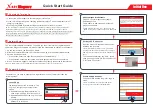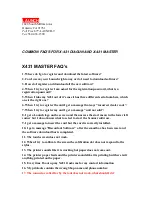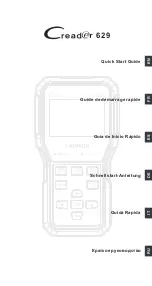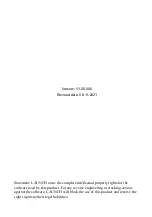
Dynalyzer – Digital Display/Printer
OPERATION MANUAL
12
Using the Preset mode allows triggering on the absolute level of kV or mA, which is displayed
directly in the Percent/Preset window. In this mode the Display eliminates any fluctuation in the
trigger level during a series of exposures. The effects of pre-trigger pulses, x-ray tube instability,
and other transient phenomena will not change the trigger level. The design minimums of 4 kV and
20 mA should be observed, however.
In the PERCENT mode, if a series of exposures is made with increasing kVp, the trigger value is
always in range. However, if the series is made with decreasing kVp, it is possible that the change
will be great enough, especially if the level is set at 75% or above, for a trigger not to occur. In this
case, depressing the CLEAR READING button resets the trigger register to a nominal value (20
kVp). Depressing the RESET pushbutton accomplishes the same purpose, but this resets the
display memory, and wipes out the background nulling calibration of the radiation probe that was
achieved during the Self Test procedure. If the button is inadvertently depressed, the radiation
probe should be re-zeroed. Refer back to “Initial Set-up and Self Test”.
Trigger Level
Proper setting of the trigger level is required in order to obtain accurate time and tube current data.
Exposure time and current are intimately related as current (mA) is a value calculated from mAs by
the Digital Display.
mA =
mAS
Exp. Time
For exposures of arbitrary lengths, no other averaging scheme can yield as accurate a result as
this formula.
For single-phase exposures, use as low a trigger level as possible (consistent with the elimination
of any electrical noise present) to obtain accurate readings. The level should be set to 10%. Lower
trigger level settings may cause false triggering but may be used if conditions permit (the minimum
kV trigger value obtainable will be 5kVp.) Increasing the trigger level results in shorter than true
exposure times. In addition, on short exposures, low mA values may not be integrated, resulting in
an mA error of +40%, if the trigger level is set to maximum. Erroneous exposure times will also be
observed.
Figure 6:
Effect of 10% Trigger Level on Exposure Time
10% TRIGGER LEVEL
0% TRIGGER LEVEL
ERROR AREA
MEASURED
READ TIME
time error =
f 360°
2 sine-1
10% level = 0.53 ms error













































